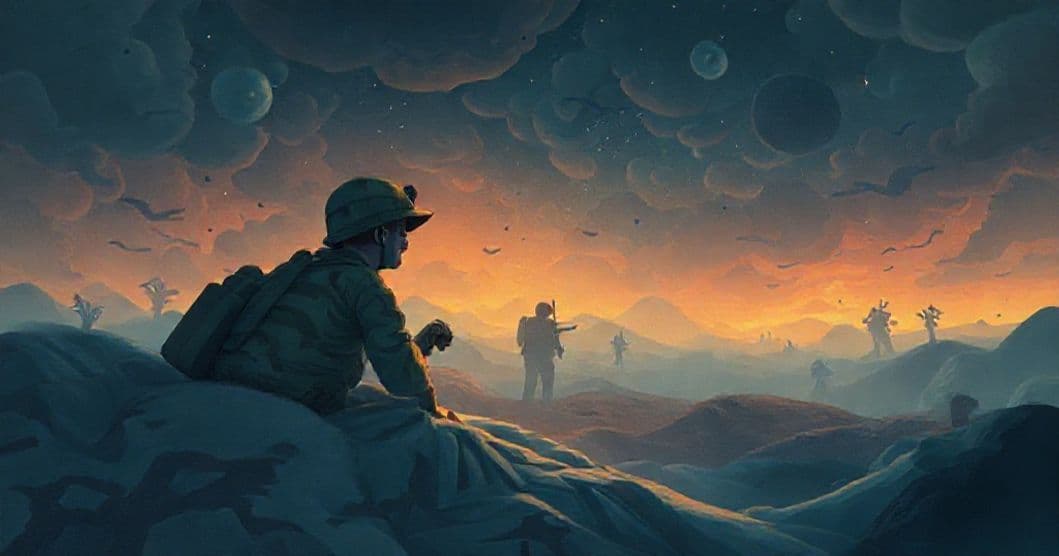The Army Dream: Navigating Commitment Fears in the Unconscious
Part 1: Dream Presentation
Dreams often serve as mirrors to our inner landscapes, reflecting tensions we may not fully acknowledge in our waking lives. Consider this recurring nightmare, which reveals the complex interplay between duty, freedom, and the fear of long-term commitment. The dream begins with the promise of purpose: the crisp uniforms, the camaraderie of new recruits, and the initial thrill of joining a structured community. This phase of the dream evokes the universal human desire for belonging and meaning, a fundamental psychological need explored by both Freud and Jung.
The narrative shifts dramatically when the dreamer realizes the four-year commitment—a concrete, unyielding timeline that transforms excitement into dread. The dream then intrudes with surreal footage from an army recruit video, its cheery narrator urging ‘embrace your destiny’ while the faces blur into strangers. This final element introduces a stark contrast between external expectations and internal resistance, creating a psychological paradox: the allure of purpose versus the terror of losing autonomy.
Part 2: Clinical Analysis
Want a More Personalized Interpretation?
Get your own AI-powered dream analysis tailored specifically to your dream
🔮Try Dream Analysis FreeSymbolic Landscape: Unpacking the Army and Recruit Video
The army itself functions as a powerful symbolic container for societal ideas about duty, structure, and sacrifice. In Jungian psychology, the military represents the ‘shadow’ archetype—the part of the psyche we project onto external systems, often containing our fears of responsibility and freedom. The four-year commitment is particularly significant: it materializes as a tangible, unbroken chain of obligation, symbolizing the fear of permanent choices and the loss of flexibility. The recruit video, meanwhile, embodies the pressure of external validation—its cheery narrator and mechanical smiles suggest the clash between institutional demands and personal authenticity.
Psychological Undercurrents: Theoretical Perspectives
From a Freudian lens, the dream may reflect repressed anxieties about life choices. The shift from excitement to dread mirrors the unconscious conflict between the ‘pleasure principle’ (initial enthusiasm) and the ‘reality principle’ (awareness of long-term consequences). Jungian theory, however, emphasizes the collective unconscious: the army as a universal symbol of duty, and the recruit video as a modern-day ‘mandate’ archetype, forcing conformity to societal expectations.
Cognitive dream research adds another layer: dreams process unresolved problems by replaying scenarios in symbolic form. Here, the recurring nature suggests the dreamer is grappling with a persistent question: How do I balance commitment with personal freedom? The dream’s structure—beginning with hope, ending with dread—mirrors the cognitive process of weighing pros and cons without resolution.
Emotional Context: Waking Life Triggers
Recurring dreams rarely exist in isolation; they respond to waking life stressors. The dreamer may be facing real-life decisions about career, relationships, or personal growth—areas where long-term commitment feels both necessary and terrifying. The four-year timeline could symbolize any situation requiring sustained dedication: a job, a relationship, or even personal goals like learning a skill. The recruit video’s surreal intrusion hints at external pressures, whether familial, societal, or professional, that demand conformity.
Therapeutic Insights: What the Dream Reveals
This dream invites reflection on the relationship between freedom and responsibility. Consider asking: What commitments am I avoiding? and What structures do I need to thrive? Journaling exercises could help explore the tension between autonomy and connection—perhaps by listing both the ‘freedom’ and ‘duty’ aspects of current choices.
For integration, the dream suggests honoring responsibility without sacrificing authenticity. One practical exercise: create a ‘commitment map’ listing short-term and long-term obligations, noting where flexibility can be maintained. This process helps externalize the internal conflict, reducing its emotional charge.
FAQ Section
Q: Why do I keep dreaming about joining the army? A: Recurring dreams often highlight unresolved conflicts. The four-year term may symbolize fears of permanent choices, while the initial excitement reflects a desire for purpose. This pattern suggests the dreamer is navigating a life transition.
Q: Is the recruit video significant? A: Yes—the surreal footage represents external pressure clashing with internal resistance. It may signal societal expectations (e.g., career, family) demanding conformity.
Q: How can I differentiate between healthy commitment and fear? A: Reflect on whether choices feel energizing or draining. Dreams like this urge us to honor both responsibility and self-preservation, finding balance between purpose and freedom.
Emotional Context: Waking Life Triggers
The dream’s emotional arc—from hope to dread—resonates with the modern experience of career and life decisions. In a society that values both achievement and flexibility, the four-year timeline may symbolize the fear of ‘selling out’ to long-term obligations without realizing the cost. The recruit video’s mechanical imagery suggests the pressure to conform to societal norms of success, even when they conflict with personal values.
Therapeutic Insights: What the Dream Reveals
This dream urges the dreamer to explore their relationship with commitment. Practical exercises include: 1) Journaling about recent decisions involving long-term obligations, noting emotions triggered. 2) Visualizing freedom and responsibility as complementary, not opposing forces. 3) Asking: What would I choose if I felt both secure and free? Integration involves honoring responsibility while maintaining self, finding purpose without surrendering autonomy.
Conclusion
The recurring army dream is more than a nightmare—it is a psychological dialogue, urging the dreamer to confront the tension between duty and freedom. By examining the symbolic layers, we uncover the deeper truth: the fear of commitment is often the fear of losing ourselves in the process of serving something larger. Through reflection and intentional action, this dream can guide the dreamer toward a healthier relationship with both responsibility and authenticity, transforming the nightmare into a roadmap for conscious living.
